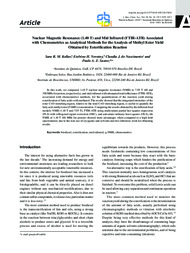Nuclear magnetic resonance (1.40 T) and mid infrared (FTIR-ATR) associated with chemometrics as analytical methods for the analysis of methyl ester yield obtained by esterification reaction.
Nuclear magnetic resonance (1.40 T) and mid infrared (FTIR-ATR) associated with chemometrics as analytical methods for the analysis of methyl ester yield obtained by esterification reaction.
Author(s): KOLLAR, S. R. M.; NOVOTNY, E. H.; NASCIMENTO, C. J. do; SUAREZ, P. A. Z.
Summary: In this work, we compared 1.40 T nuclear magnetic resonance (NMR) to 7.05 T (60 and 300 MHz for proton, respectively), and mid-infrared with attenuated total reflectance (FTIR‑ATR), associated with chemometrics methods, for the quantification of the reaction yield during esterification of fatty acids with methanol. The results showed that the integrated intensities of the ester C=O stretching region, relative to the total C=O stretching region, is useful to quantify the fatty acid methyl ester (FAME) concentration. Comparing the results obtained by the different final models: NMR (1.40 T and 7.05 T), FTIR-ATR using multivariate partial last squares regression (PLS) with orthogonal signal correction (OSC), and univariate ordinary least squares (OLS), the NMR of 1.40 T (60 MHz for proton) showed more advantages when compared to a high field spectrometer, due to the non-use of cryogenic and solvents and less laborious work for obtaining results.
Publication year: 2017
Types of publication: Journal article
Unit: Embrapa Soils
Keywords: Esterificação, Infravermelho médio, Q-RMN, Quimiometria, biodiesel
Observation
Some of Embrapa's publications are published as ePub files. To read them, use or download one of the following free software options to your computer or mobile device. Android: Google Play Books; IOS: iBooks; Windows and Linux: Calibre.
Access other publications
Access the Agricultural Research Database (BDPA) to consult Embrapa's full library collection and records.
Visit Embrapa Bookstore to purchase books and other publications sold by Embrapa.

